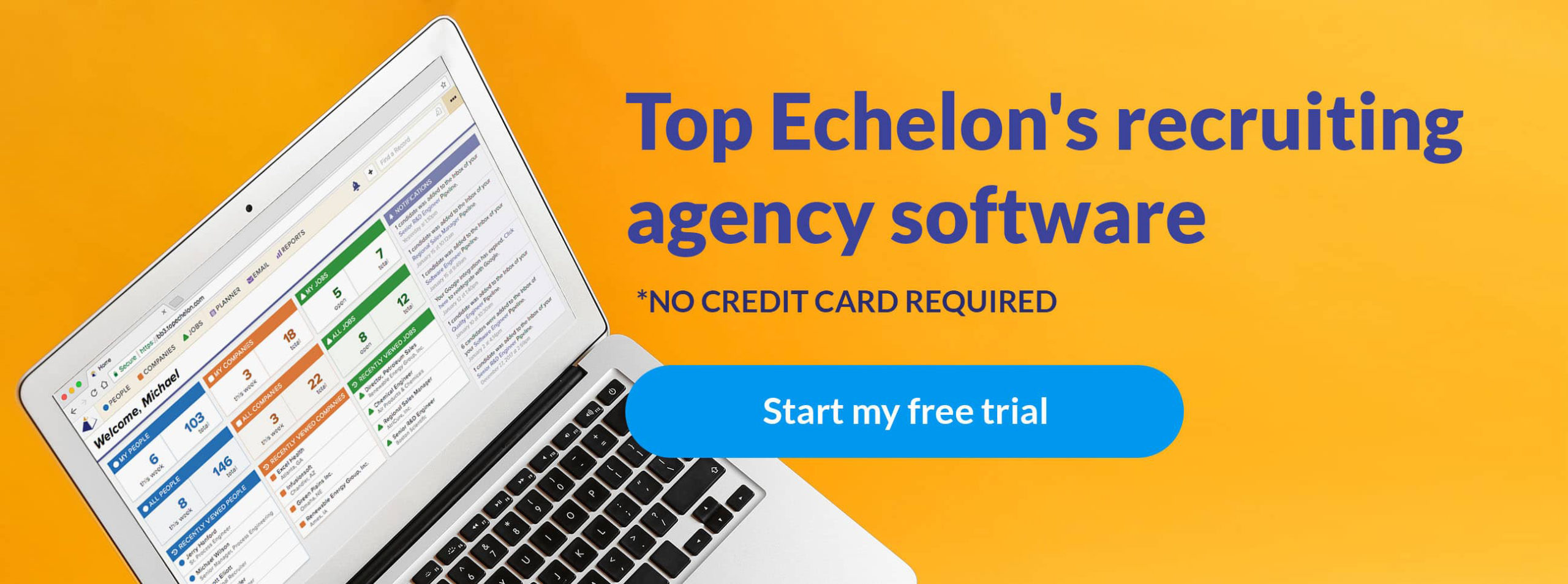As a recruiter, you know your job is to source top talent and convince candidates to work for your client. Sometimes, candidates turn down job offers, or new hires might leave after a few months. To prevent this from happening, your client needs to create an employee value proposition.
What is an employee value proposition?
An employee value proposition, or EVP, includes all the benefits an employee receives from working at a business. Employee value propositions help companies attract and retain top talent. A strong EVP will result in the employee furthering their compensation, opportunities, professional relationships, and work-life balance as a result of their position within a company.
EVP is also when an employee respects and enjoys working at a business as a result of a strong employer brand.
In EVP recruitment, you focus on the candidate and how the position would help them grow as a professional. In order to do this, you need to know the employee value statement.
An employee value proposition works similarly to a customer value proposition. With a customer value proposition, a business develops a mission statement or marketing purpose that tells customers why they should buy from them.
Think of an employee value proposition as a sales pitch. Why should the candidate accept the job? Why shouldn’t a current employee leave? What value does the potential or current employee receive from working at your client’s company? These questions should be answered with an employee value proposition model.
Since it is a candidate’s market, you must incorporate an employee value proposition into the recruiting and hiring process steps.
Recruiting trends from the Top Echelon 2016-2017 State of the Recruiting Industry report found that 24.5% of candidates turn down a job offer because others are better. An EVP should highlight why your client’s job offer is the best.
To see the latest recruiting industry statistics, download the Top Echelon 2016-2017 State of the Recruiting Industry report.
Why having an EVP is important
You want to fill job orders, satisfy your clients, and get paid. Having an EVP can help you get there. There are many benefits of an EVP, including the ability to:
- Source talented individuals
- Get talent to accept a job offer
- Engage the workforce
- Create brand ambassadors
- Reduce employee turnover rates
Finding and keeping the best talent starts with making sure they are good fits for the company. Then, you need to make sure candidates understand the benefits of working for your client. Be sure to leverage your applicant tracking system to customize your candidate outreach with details about your client’s EVP.
Don’t miss out on a strong placement because you and your client can’t convey the benefits of working at the company.
How to create an employee value proposition
Having a strong recruiting strategy starts with knowing how to make an EVP. You can help your client create an EVP and convey it to candidates.
Try these tips to help your client create an employee value proposition.
1. Highlight attractive benefits in compensation packages
Your client might have limited funds and can’t offer the highest salaries. But, this doesn’t have to be a hindrance when it comes to sourcing new candidates.
Although candidates value a reasonable salary for their work, they also value benefits like health insurance, retirement plan options, personal time off, and flexible work schedules. In fact, four in five employees value benefits over pay raises.
As the recruiter, it is your job to show candidates how the overall compensation package can benefit them. For example, emphasize the option to work remotely if your client offers that.
Show candidates what your client is able to provide that other businesses cannot. By highlighting the unique qualities of the compensation package, you can show candidates that they will receive value and benefits from your client’s company.
And, you can encourage your client to evaluate compensation packages for current employees. This can help them to retain their top talent.
2. Listen to potential and current employee questions, ideas, and complaints
In many cases, you are the lifeline for candidates. You are the go-to contact that passes information between candidates and clients.
Answer any questions candidates have and set up extra meetings if requested. Make sure you are available for candidates. Keep them updated on where they are in the recruiting process.
According to one Gallup poll, employee engagement was highest when managers took the time to communicate with their employees. And, employees who had regular meetings with managers were almost three times more engaged than those who did not. This shows that employees value employers who listen. And, they want the same from you.
Show the candidates that your client values questions by being an ambassador for your client.
Help your clients continue this mentality even after your job is done. Your clients should continue to talk with employees and make sure they are content.
3. Address growth opportunities within the company
Another important part of an employee value proposition is whether candidates and employees have opportunities to grow within the company.
As a recruiter, you need to talk with candidates about possibilities of the open position. And, you need to be clear about financial (e.g., raises) and professional (e.g., promotions) development and growth opportunities.
The opportunity to develop and grow within a company is important to employees. Another Gallup poll found that 59% of millennials, 44% of Gen Xers, and 41% of baby boomers said that growth opportunities were important when applying for a job. And, 87% of millennials and 69% of non-millennials found growth opportunities important when talking about their current jobs.
Talk with your client before you make empty promises. Understand the potential growth opportunities they offer as well as what strengths employees need to receive them.
4. Describe company culture
EVP branding requires candidates to understand company culture. Company culture is the set of beliefs that dictate interactions between employees.
If your client has worked hard to foster teamwork among current employees, explain this to the candidates. Talk to the candidates about different activities your client does to improve teamwork.
Maybe your client hosts monthly company-wide meetings to get employees on the same page. Or, they might host fun events that boost teamwork. Explain anything your client does to improve their workforce and what the candidate can expect if they accept an offer at the business.
If the company atmosphere is relaxed, tell candidates. Let candidates know exactly what the company is like and how they will fit in if they are hired.
5. Accurately convey the company’s mission
People want to feel a sense of purpose in their work. Candidates and employees need to know that the work at your client’s company is important. Generally, a company’s mission statement should convey the goals of the company.
If your client does not have a strong and clear mission statement, point this out to them. You can even help them come up with an accurate description of their company’s goals.
Once your client has a mission statement, show candidates how the open job’s responsibilities can impact customers and the company overall.
Paint an accurate and attractive picture of the company culture. Show candidates why they would want to be a part of this mission.
Continue adapting the EVP
Creating an EVP isn’t a one-time task. Your clients should continually examine, measure, and improve employee value proposition.
Here are some ways your client can do this:
- Pass out company culture surveys to employees
- Pay attention to each employee’s morale during performance reviews
- Ask candidates what they look for in a job
- Conduct industry research to see what competitor businesses offer
- Listen to candidates and employees
As a recruiter, you play an active role in the hiring process. Most likely, your client values your opinion. Extend your knowledge on employee value proposition strategies to help increase the number of candidate applications, satisfaction, and job acceptance rates.









